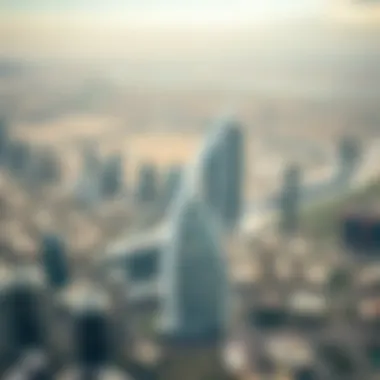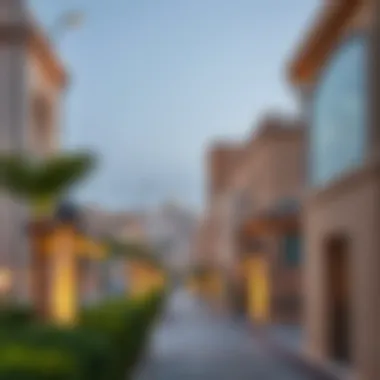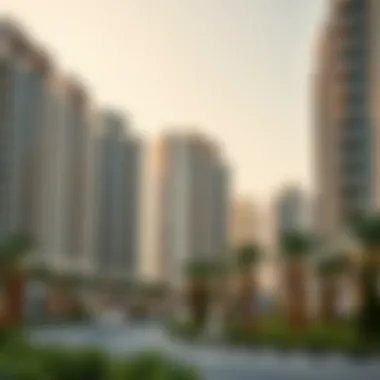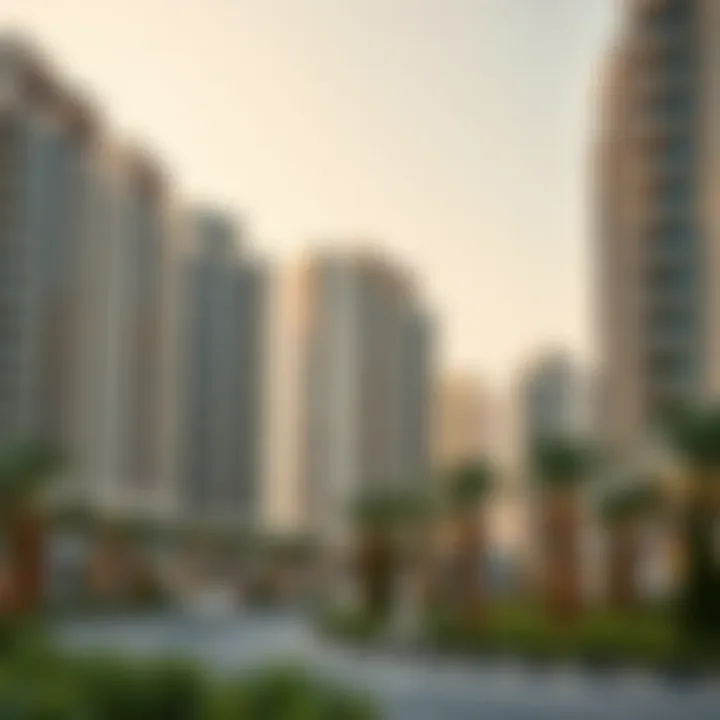Geographical Insights: Dubai vs. Sharjah


Intro
When it comes to the landscapes of the Emirates, Dubai and Sharjah present a fascinating study in contrast and convergence. Each emirate reveals a unique blend of cultural heritage and modern ambition, influencing their urban sprawl, property dynamics, and overall appeal in the real estate market.
Dubai, known as the glitzy jewel of the UAE, attracts global attention with its skyline dotted by towering structures such as the Burj Khalifa. Its urban planning reflects a relentless pursuit of innovation and luxury. On the other hand, Sharjah stands as the cultural heartbeat of the UAE, prioritizing art and tradition amidst its development efforts. The geographical uniqueness of both places not only shapes their identities but also impacts property investment and residential choices significantly.
In this analysis, we shall delve into the market trends, investment strategies, and the geographical characteristics that set both emirates apart. Our aim is to provide would-be investors, expatriates, and homeowners with a wealth of insights and actionable data as they navigate the real estate scene.
Market Trends
Current Property Prices
Understanding the present landscape of property prices in Dubai and Sharjah is crucial for potential investors. Generally, property prices in Dubai cater to a diverse demographic and range broadly from luxurious penthouses in Downtown Dubai to more affordable apartments in the suburbs. As of recent data, prices in prime locations hover around AED 2,400 per square meter while areas further from the center can see prices dip below AED 1,000.
Sharjah, though less glitzy, offers commendable value, with prices often more attractive than its neighbor. Residential options here may cut down to AED 800 per square meter in some regions, providing an enticing opportunity for first-time buyers. This affordability makes Sharjah a compelling alternative for families and expatriates wanting a more traditional community feel while still being in proximity to Dubai.
Future Market Predictions
Looking ahead, the real estate trajectories for both Dubai and Sharjah seem promising, albeit influenced by distinct factors. Dubai’s continuous push for mega-projects and its appeal as a tourist hub will likely keep property values afloat. Reports suggest a steady increase, predicting a climb of roughly 5-10% annually over the next few years, driven by foreign investments and upcoming events like World Expo.
Conversely, Sharjah's growth will likely follow a different path, focused on sustainability and cultural projects that foster community-driven development. Property analysts speculate a moderate but steady growth of around 3-7% in Sharjah, reflecting its enhancements in amenities, education, and cultural attractions.
"Understanding the nuanced differences between Dubai and Sharjah is essential for making informed real estate decisions. The geographical contexts shape not just the prices but the lifestyle options as well."
For more insights and updates on real estate trends, please visit Dubai Property, Sharjah Real Estate, or check resources on Wikipedia and Britannica.
Overview of Dubai and Sharjah
In this section, we will explore Dubai and Sharjah, two of the most significant emirates in the United Arab Emirates (UAE). Understanding the geographical insights of these areas is paramount for anyone interested in the real estate sector or planning to relocate here. Dubai, known for its towering skyscrapers and cosmopolitan lifestyle, contrasts Sharjah, which is often viewed as a cultural and educational hub. Both emirates have their own unique qualities that cater to different lifestyles and investment preferences.
Assessing the geographical distinctions presents various benefits, such as identifying investment opportunities and understanding the regional dynamics that affect real estate. For investors or potential homeowners, recognizing the location, layout, and developmental strategies of both emirates can directly influence purchasing decisions. Moreover, as globalization remains a driving force, tailored insights into Dubai and Sharjah offer a compass to navigate the varying facets of living and working in these areas.
Setting the Stage
Dubai and Sharjah hold a special spot in the Gulf region's economic landscape. With strategic positioning along the southern shore of the Arabian Gulf, they share boundaries that not only define their geographical limits but also their economic and cultural interactions. Picture a canvas where the vibrant hues of Dubai blend into the more subdued tones of Sharjah.
Dubai, a leading global city, is all about luxury and modernity. From the notorious Burj Khalifa that scrapes the sky to expansive shopping malls, the emirate encapsulates a fast-paced lifestyle. Conversely, Sharjah embraces a different essence, prioritizing heritage, art, and a more tranquil living environment. This dichotomy sets an intriguing stage for any exploration into their geographical nuances.
Historical Context
To appreciate the present-day realities of Dubai and Sharjah, one must delve into their historical backgrounds. Dubai's rise as a trade hub has its roots in ancient civilizations, where it was a small fishing village before evolving into a major trading port. The discovery of oil in the 20th century catalyzed its rapid development, transforming the emirate into a beacon of innovation and luxury.
In comparison, Sharjah has long been recognized as the cultural capital of the UAE. Its history dates back to the Stone Age, and it has preserved its heritage more diligently than some of its neighbors. Sharjah’s historical significance is highlighted by numerous museums, art institutions, and cultural festivals that underscore its commitment to education and tradition.
By understanding their pasts, we can gather insights into how Dubai and Sharjah have developed their unique identities, shaping their landscapes and urban planning. This historical lens informs potential real estate investments by revealing patterns and trends that may impact future developments.
Geographical Size and Boundaries
Understanding the geographic scale and boundaries of Dubai and Sharjah is essential for grasping their roles in the UAE's development. The size and configuration of each emirate not only influence planning and zoning laws but also have a significant impact on real estate dynamics and lifestyle choices available to residents. As a prospective investor, knowing the territorial extent and how it affects economic and urban development can be a game-changer.
Land Area of Dubai
Dubai spans an impressive land area of approximately 4,114 square kilometers. This vast expanse is not just a number; it is indicative of the emirate’s ability to accommodate a growing population and burgeoning economic activities. The strategically designed city layout ensures that essential amenities, recreational areas, and commercial hubs are within a convenient reach. With its iconic skyline, inclusive of landmarks such as the Burj Khalifa and the Palm Jumeirah, the land utilization in Dubai has been optimized to attract tourists and businesses alike.
The city's growth trajectory indicates a conscious effort to expand outward, balancing urban density with green spaces. Lakes, parks, and community areas have sprouted amidst skyscrapers, creating a blend of urban living and nature, making it appealing for homebuyers and expatriates. The expansion initiatives, like the Dubai South project, are aimed at making room for 500,000 residents, showcasing the emphasis on strategic urban planning.
Land Area of Sharjah


In contrast, Sharjah covers a land area of about 2,590 square kilometers, making it the third largest emirate in the UAE. It is landlocked, bordered by Dubai to the south and the Arabian Gulf to the north. The boundaries create unique challenges and opportunities for the emirate, which has a rich cultural heritage that set it apart. Sharjah’s urban layout is markedly influenced by its drive towards preserving its heritage while promoting economic growth.
Although smaller than Dubai, Sharjah offers its own charms, from its historical districts to its prominent arts and cultural institutions. The emirate's commitment to building family-friendly environments with ample educational facilities is evident. Moreover, initiatives such as the construction of the Aljada community depict how new developments can marry modern living with cultural roots.
Comparative Scale
When comparing the geographical sizes of both emirates, it is essential to understand not just the figures but what they represent.
Dubai: 4,114 km²
Economic power, rich in luxury tourism, commercial activities, and innovation zones.
Sharjah: 2,590 km²
Cultural hub, focuses on family-oriented living and preserving heritage.
The size of Dubai allows for extensive infrastructure projects, leading to swift urban expansion. In comparison, Sharjah's compact territory encourages thoughtful development strategies that emphasize community and culture.
Both cities capitalize on their geographical attributes to attract different demographics. Investors focusing on high-end luxury properties may lean towards Dubai, while those interested in family-oriented environments might find Sharjah to be a better fit. Understanding the geographical nuances thus serves as a foundation for making informed real estate decisions.
In summary, the geographical size and boundaries of Dubai and Sharjah significantly shape their urban landscapes and development strategies, making it imperative for investors and residents to comprehend these aspects to navigate the real estate market effectively.
Urban Development and Expansion
Urban development often captures the essence of a city's growth and evolution. In the context of Dubai and Sharjah, understanding urban development and expansion sheds light on their distinctive characteristics and opportunities, especially for those interested in real estate. The dynamic nature of these emirates presents a unique canvas for investors, homeowners, and expatriates alike. It emphasizes how development policies, infrastructure improvements, and urban planning influence not just lifestyle but economic viability as well.
Dubai’s Urban Landscape
Dubai's urban landscape is a marvel of modern architecture and bold initiatives. The city has transformed over the past few decades from a small trading port to a cosmopolitan hub. Skyscrapers dominate the skyline, with the Burj Khalifa being the most notable example, standing as the tallest building in the world. Urban planners have embraced innovative designs and sustainable practices, creating a multifunctional space.
The infrastructure in Dubai is highly developed, with an extensive road network and public transport options like the Metro. Residential areas such as Dubai Marina and Downtown Dubai offer not just luxurious living but also easy access to entertainment and business centers. The city is designed to cater to the needs of a diverse population, attracting professionals from various fields.
Real estate developers in Dubai continuously set the stage for futuristic projects. For instance, the Expo 2020 site, now known as District 2020, is being reimagined to sustain economic activity. The area will transform into a mixed-use community, showing that urban design here is inherently adaptive.
Sharjah's Urban Dynamics
While Sharjah may not boast the same global fame as Dubai, its urban dynamics tell a compelling story of cultural preservation and growth. Culturally rich, Sharjah remains the UAE’s cultural capital. Its architecture retains elements of traditional Emirati design while integrating modern aesthetics. The city is home to numerous museums, art galleries, and institutions, making it a center for arts and education.
Sharjah has also seen significant urban expansion, although at a slower and more measured pace compared to its neighbor. The Emirate focuses on creating a balanced atmosphere between residential and communal spaces. Areas like Al Qasba highlight this blend, offering lakeside leisure spots while promoting local businesses. Its development plans often emphasize quality of life over sheer quantity, focusing on providing parks, educational institutions, and cultural spaces.
Trends in Development
Both cities reflect distinct trends in urban development reflective of their identities. In Dubai, the trend is marked by rapid paces, cutting-edge technology, and an eye toward sustainability. Sharjah, on the other hand, seems to be taking a more measured approach, balancing modern developments with traditional values.
"In essence, Dubai races towards the future, while Sharjah embraces its rich heritage amid growth."
Investors should be aware of these trends when making decisions. For instance:
- Dubai's Priority on Vertical Growth: High-rise buildings and compact living spaces are designed to maximize land use.
- Sharjah's Focus on Community-Centric Development: Creating neighborhoods that cater to families and promote community interaction.
The interaction between these urban development trends opens avenues for investments tailored to specific buyer preferences, whether one is looking to benefit from cosmopolitan Dubai or settle into the culturally-inclined Sharjah.
Cultural and Economic Zones
Understanding the cultural and economic zones within Dubai and Sharjah is crucial for investors and homebuyers alike. These zones represent not only the vibrant life and opportunities but also the foundation upon which the real estate landscape is built. The distinct cultural attributes and economic hubs both serve as significant factors shaping how properties are valued, what communities are formed, and ultimately influence lifestyle choices.
Cultural Significance of Dubai
Dubai is a melting pot of cultures, attracting expatriates from across the globe. This cultural diversity is reflected in its architecture, food, and festivals. Places like the Dubai Opera, and Global Village, showcase the city's commitment to fostering a rich tapestry of cultural experiences. The Dubai Mall isn't just a shopping destination; it also houses artistic works, promoting local creativity alongside international talent.
Moreover, events such as the Dubai Shopping Festival and Art Dubai draw visitors year-round, enhancing the city’s cultural footprint. These events can be a boon for the real estate market, as areas near cultural hotspots see increased demand. For prospective buyers, this cultural significance can add layers of appeal to property investments, as living in proximity to such venues means being part of a dynamic communal life that goes beyond mere residential experience.


Economic Hubs in Sharjah
While Dubai often steals the limelight, Sharjah is quietly establishing itself as a pivotal economic player in the UAE. The emirate is home to various free zones, such as the Sharjah Airport International Free Zone (SAIF Zone) and Hamriyah Free Zone, which have attracted numerous businesses looking for cost-effective setups without compromising on quality and accessibility.
Sharjah’s focus on education and cultural tourism also plays a significant role in its economy. Its institutions, like the University City, provide a steady stream of students and professionals, facilitating a diverse job market. The health sector, with its world-class hospitals like Al Qassimi Hospital, further lures residents seeking premium care services. For investors, the potential for growth in Sharjah’s economic zones can present lucrative opportunities, especially in the residential and commercial real estate sectors.
Influence on Real Estate
Cultural and economic frameworks directly shape the real estate market in both emirates. In Dubai, luxury high-rises and exclusive communities cater to a clientele seeking a cosmopolitan lifestyle. The proximity to cultural hotspots enhances property values, making certain neighborhoods more desirable than others. Properties near Downtown Dubai are often seen as prime investments due to their cultural significance and vibrant atmosphere.
In Sharjah, the real estate market is characterized by a more modest but steadily growing demand. As Sharjah enhances its appeal through cultural initiatives and open public spaces, properties in emerging neighborhoods, such as Al Zahia, are gaining traction among families and investors alike.
In essence, understanding the interplay between cultural significance and economic hubs is vital for navigating the real estate landscape. It sheds light on where real value lies, enabling informed investment decisions.
By encompassing both cultural vibrancy and economic vitality, the insights garnered from these zones are indispensable for anyone contemplating investments or settling down in these dynamic emirates.
Transportation Infrastructure
Transportation infrastructure plays a pivotal role in the economic and social landscape of any urban area. In the context of Dubai and Sharjah, the efficiency and layout of transportation systems directly impact property values, accessibility, and overall quality of life. A solid transportation network not only facilitates ease of movement for residents and visitors but also acts as a magnet for businesses and investors looking to set down roots. It’s a common understanding that well-connected cities thrive, attracting talent, tourism, and trade.
Major Transportation Networks in Dubai
Dubai boasts an extensive transportation network that reflects its status as a global city. The city features a mix of modern solutions tailored to meet the needs of its diverse population.
- Metro System: The Dubai Metro, launched in 2009, serves as a backbone for mass transit. Stretching over 75 kilometers, it connects key areas of the city, including the Dubai International Airport and various business hubs. This mode of transport is not only efficient, but also cost-effective, making it a preferred choice among daily commuters.
- Road Networks: Dubai's road infrastructure is equally impressive, with expansive highways such as Sheikh Zayed Road facilitating swift vehicular movement. This creates a seamless flow between Dubai and neighboring emirates. The lack of heavy traffic jams often associated with other metropolitan areas makes commuting in Dubai relatively stress-free.
- Water Transport: With a historical reliance on trade via sea, Dubai still embraces its maritime roots. Water taxis and the Dubai Ferry provide alternative transport options, catering especially to the tourist sector.
The combination of these transportation modalities enhances Dubai's urban landscape and promotes connectivity.
Connectivity of Sharjah
Sharjah, in contrast, has developed a unique transportation infrastructure suited to its specific needs. While it may not be as extensive as Dubai’s, Sharjah's connectivity is efficient and user-friendly.
- Public Transportation: Sharjah public buses connect various areas within the emirate and facilitate travel to neighboring Dubai. The buses are timely and affordable, promoting their use among residents.
- Road Access: Major highways, such as the Emirates Road, allow for smooth access to Dubai and other emirates, which is crucial given the proximity of the cities. Commuters frequently travel between Sharjah and Dubai for work, further binding the two emirates together.
- Air Travel Connections: While Sharjah International Airport serves as a gateway for numerous low-cost airlines, it plays a significant role for travelers looking for budget-friendly options, making it a valuable addition to the transportation mix.
Impact on Property Access
The transportation infrastructure affects property access in myriad ways. For investors and potential homeowners, understanding this aspect is crucial when making real estate decisions.
- Accessibility and Property Value: Properties located near major transportation nodes, like the Dubai Metro stations or along bus routes in Sharjah, tend to have higher demand and command better prices. Buyers often factor in proximity to transport links when evaluating a community’s livability.
- Influence on Development Trends: Areas with growing transport networks often see an uptick in new developments. Builders are aware that ease of transportation is a strong selling point, thus driving urban planning toward connective routes.
- Lifestyle Considerations: Long commute times can lead to reduced desirability of properties located far from key transport routes. Conversely, areas that promise quick access to work and amenities often attract families and professionals seeking convenience.
In summary, both Dubai and Sharjah showcase the critical role transportation infrastructure plays in shaping real estate opportunities. As urban landscapes evolve and expand, savvy investors will continue to monitor these dynamics, ensuring their decisions are guided by sound geographical insights.
Environmental Aspects
When considering the real estate landscape in Dubai and Sharjah, understanding the environmental factors that shape these emirates is crucial. Not only do these aspects affect the quality of life for residents, but they also influence investment opportunities and urban planning decisions. Environmental considerations are pivotal in attracting investors, homebuyers, and developers, who are increasingly becoming aware of sustainability and ecological impacts of their investments.
Climate Factors in Dubai
Dubai’s climate can be best described as arid. The summer months are often blisteringly hot, with temperatures frequently soaring above 40°C (104°F). With limited rainfall, the city has developed a reliance on air conditioning and extensive water management systems. The high temperatures and humidity during certain periods necessitate careful planning in urban development. For instance, buildings are designed to minimize energy use, with reflective materials and shaded areas becoming common features.
Moreover, the city experiences occasional dust storms, impacting air quality. To tackle these, the local government has implemented various measures, from improving green spaces to enhancing public transportation to reduce vehicle emissions. The weather patterns, while extreme, also create unique opportunities for luxury resorts and outdoor attractions during the cooler months, leading to increased tourism.
Environmental Considerations in Sharjah
Sharjah presents a different environmental picture compared to its neighbor. With a more diverse topography, comprising coastal areas and semi-arid landscapes, Sharjah faces its own set of environmental challenges. The emirate places significant emphasis on preserving its natural resources. While urbanization continues to expand, Sharjah's government has aimed for a balanced approach between development and conservation.
The emirate has championed initiatives to protect its coastal ecosystems. Efforts like beach clean-up campaigns and regulations on pollution show commitment to environmental stewardship. Additionally, there are many areas dedicated to wildlife protection, demonstrating a recognized need to sustain biodiversity alongside urban growth.


Sustainability Initiatives
Both Dubai and Sharjah are increasingly focusing on sustainability initiatives. In Dubai, the Dubai Clean Energy Strategy 2050 aims to make the emirate a global center for clean energy and green economy. Projects like the Mohammed bin Rashid Al Maktoum Solar Park exhibit a significant push towards renewable energy sources. Moreover, policies to encourage green buildings have transformed the real estate market, making properties more energy-efficient.
In Sharjah, sustainability manifests through projects such as Sharjah’s Sustainable City which integrates residential areas with lush landscape, powered by renewable energy. The emphasis is on creating communities that promote healthier living while being mindful of energy consumption. This initiative not only promotes eco-friendly practices but also attracts families looking for a more sustainable lifestyle.
"Embracing sustainability is not just about protecting the environment; it's about ensuring a better quality of life for future generations."
Real Estate Market Dynamics
Understanding the dynamics of the real estate market is essential for anyone looking to invest or make a home in Dubai and Sharjah. The real estate landscape reflects various facets of the economy, demographics, and urban policies, influencing buyers and sellers alike. Both emirates offer distinct characteristics shaped by their geographical and socio-economic frameworks. This section will explore pricing trends, insights into the Sharjah market, and a comparative analysis that brings clarity to prospective buyers or investors.
Pricing Trends in Dubai
Dubai’s property market is often seen as a bellwether for the entire region due to its rapid development and international appeal. The trends here frequently pivot on several factors — demand from expatriates, luxury offerings, and government policies aimed to stimulate foreign investment. In the wake of the COVID-19 pandemic, the market experienced significant fluctuations, but recent years have shown a resilient recovery.
Factors Influencing Prices:
- Population Growth: Dubai's expatriate population continues to surge, driving demand.
- Tourism: As one of the world’s top destinations, tourism impacts short-term rental markets and hotel developments, which in turn affect long-term housing supplies.
- Government Initiatives: Recent visa reforms and the introduction of freehold ownership for foreigners have further spurred interest in real estate.
In terms of pricing, luxury developments often command premium rates. However, there has been a significant uptick in mid-range properties as the market seeks to accommodate a diverse clientele. For instance, prices in popular districts like Dubai Marina and Downtown have shown steady increases, while areas like Al Quoz experienced more diverse pricing due to a mix of residential and commercial developments.
Sharjah Real Estate Insights
In contrast to the sparkling skyline of Dubai, Sharjah offers a blend of cultural richness and affordability. The emirate's real estate market has grown, particularly in areas that cater to families looking for larger living spaces at more accessible price points.
Key Aspects of the Sharjah Market:
- Affordability: Sharjah remains a haven for families and expatriates seeking value without compromising on quality. Prices per square foot in Sharjah often sit considerably lower than in Dubai, making it an appealing option for many.
- Cultural Attractions: The emirate is rich in heritage, with numerous art festivals and museums, making it appealing to those who value cultural experiences alongside urban living.
- Community Feel: Unlike the bustling lifestyle in Dubai, Sharjah's neighborhoods tend to offer a quieter, community-oriented lifestyle, attracting a diverse demographic.
Furthermore, the emergence of new developments, like Aljada, has reshaped the landscape. These projects integrate residential, commercial, and leisure facilities, catering to a contemporary lifestyle.
Comparative Market Analysis
When comparing the real estate markets of Dubai and Sharjah, it’s crucial to assess the nuances that make each attractive to different segments of investors.
Future Prospects
In analyzing the geographical insights of Dubai and Sharjah, future prospects represent a crucial facet. As we step into dynamic shifts in urban landscapes, it becomes evident how each emirate is venturing into a phase of anticipated development. These insights serve not just to outline possibilities but to guide savvy investors and prospective homeowners in making judicious decisions that hinge on emerging trends and opportunities. Understanding future prospects lays the groundwork for potential investments, validating why keeping a finger on the pulse of development is essential.
Anticipated Growth in Dubai
Dubai stands tall as a beacon of progress, characterized by its ceaseless ambition for growth. The anticipated growth trajectory is driven by both population influx and infrastructural advancements. With projects such as the Dubai Creek Tower set to redefine the skyline, there’s an undeniable momentum sparking from governmental efforts to diversify the economy away from oil reliance.
A crucial factor contributing to this growth is the government’s Plan 2040, which brings a structured vision aligning land-use strategies with sustainable practices. Increased foreign investments in real estate further stimulate this growth arena, as non-residents continue to explore ownership avenues. The current trend showcases a budding interest in mixed-use developments like those found in Dubai Marina, appealing to both residents and investors.
As property types become more varied, ranging from luxury apartments to affordable housing complexes, the diversity in offerings enhances the attractiveness of Dubai as a global hub. Not only does this foster residential opportunities, but it also paves the way for commercial ventures, making places like Business Bay hot spots for entrepreneurs. The synergy between this growth and the rising standard of living illuminates Dubai as a promising prospect for both short-term gains and long-term investment stability.
Sharjah's Development Outlook
Unlike its flashier neighbor, Sharjah takes a different approach towards growth, emphasizing a balance between tradition and modernization. The emirate has adopted a robust development plan that revolves around its rich cultural heritage while investing in modern facilities. The Sharjah Urban Planning Council is instrumental in this transformation, propelling the development of tourism and education sectors.
The strategic positioning of Sharjah within the UAE makes it a valuable asset for further expansion. For instance, the planned Sharjah Waterfront City project reflects an ambition to integrate luxurious living with environmental sustainability. The presence of prestigious educational institutions has also been pivotal in attracting families and expatriates, fostering a stable residential community.
This development outlook positions Sharjah as an attractive option for those keen on quieter, community-driven environments without sacrificing access to urban amenities. The emphasis on educational and cultural investments indicates a future where quality of life and economic benefits go hand in hand, thereby enhancing its real estate market.
Strategic Planning Approaches
A well-thought-out strategy is key to understanding how both Dubai and Sharjah will navigate future developments. Dubai's approach leans heavily towards high-profile projects, underpinned by its status as a global city. Here, concepts like sustainable city initiatives and smart city mechanisms play a strategic role in shaping urban fabric. These initiatives focus on promoting eco-friendly environments while modernizing living spaces, thus inviting eco-conscious investors.
Conversely, Sharjah employs a more grounded strategy, emphasizing community engagement and cultural conservation. The installation of mixed-use developments and careful zoning ensures that growth does not hinder the cultural tapestry of the region. Sharjah aims to retain its unique identity while inviting strategic investments through the establishment of free zones.
By understanding these differing strategic planning styles, stakeholders can better position themselves within the real estate landscape of both emirates. Each offers varied yet appealing avenues for investments that cater to diverse consumer needs.
As both emirates shape their future to suit modern demands, they carve out distinct narratives, encouraging investors to assess their personal and professional alignment with these evolving landscapes.



